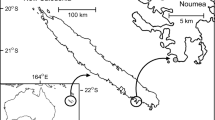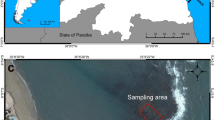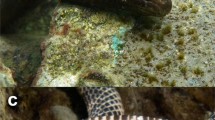Abstract
This paper presents the results of the first field study of the Brazilian endemic damselfish Stegastes rocasensis. Underwater data were collected at the Fernando de Noronha Archipelago (NE Brazil), where four sites were visually assayed for local territorial and feeding behaviors, as well as habitat use. S. rocasensis preferentially fed on turf and macroalgae, and during the afternoon period. Its territory size ranged from 0.26 to 13.86 m2 (1.61 ± 0.23 m2). Our findings suggest that adults preferably inhabit shallow, turf-rich areas, while sub-adults and juveniles occupy deeper areas with higher percent cover of invertebrates and hard corals, respectively. With regards to agonistic behaviors, pursuit of intruders was the most frequent reaction recorded (p < 0.001); the highest level of aggression was elicited by territorial herbivores (p < 0.001). Nevertheless, analysis of attacks elicited by different fish species within S. rocasensis’ territory showed that more attacks were launched on conspecifics than on other fish species.






Similar content being viewed by others
References
Alwany M, Thaler E, Stachowitsch M (2003) Food selection in two corallivorous Butterflyfishes, Chaetodon austriacus and C. trifascialis, in the Northern Red Sea. Mar Ecol 24(3):165–177
Barneche DR, Floeter SR, Ceccarelli DM, Frensel DMB, Dinslaken DF, Mário HFS, Ferreira CEL (2009) Feeding macroecology of territorial damselfishes (Perciformes: Pomacentridae). Mar Biol 156:289–299
Bell T, Kramer DL (2000) Territoriality and habitat use by juvenile blue tangs, Acanthurus coeruleus. Environ Biol Fish 58:401–409
Bohnsack JA, Bannerot SP (1986) A stationary visual census technique for quantitatively assessing community structure of coral reef fishes. NOAA Tech Rep 41:1–15
Bonaldo RM, Krajewski JP, Sazima C, Sazima I (2006) Foraging activity and resource use by three parrotfish species at Fernando de Noronha Archipelago, tropical West Atlantic. Mar Biol 149:423–433
Booth DJ (2002) Distribution changes after settlement in 6 species of damselfish (Pomacentridae) in One Tree Island lagoon, Great Barrier Reef. Mar Ecol Prog Ser 226:157–164
Brawley SH, Adey WH (1977) Territorial behavior of threespot damselfish (Eupomacentrus planifrons) increases reef algal biomass and productivity. Environ Biol Fish 2(1):45–51
Brock VE (1954) A preliminary report on a method of estimating reef fish populations. J Wildl Manag 18:297–308
Caldecott JO, Jenkins MD, Johnson T, Groombridge B (1994) Priorities for conserving global species richness and endemism. World Conservation, Cambridge
Carvalho-Filho A (1999) Peixes da costa brasileira. Melro, São Paulo
Ceccarelli DM (2007) Modification of benthic communities by territorial damselfish: a multi-species comparison. Coral Reefs 26(4):853–866
Ceccarelli DM, Jones GP, McCook LS (2001) Territorial damselfish as determinants of the structure of benthic communities on coral reefs. Oceanogr Mar Biol Annu Rev 39:355–389
Ceccarelli DM, Jones GP, McCook JL (2005a) Effects of territorial damselfish on an algal-dominated coastal coral reef. Coral Reefs 24:606–620
Ceccarelli DM, Jones GP, McCook JL (2005b) Foragers versus farmers: contrasting effects of two behavioural groups of herbivores on coral reefs. Oecologia 145:445–453
Choat JH (1991) The biology of herbivorous fishes on coral reefs. In: Sale PF (ed) The ecology of fishes on coral reefs. Academic, San Diego, pp 120–155
Davies NB, Houston AI (1984) Territory economics. In: Krebs JR, Davies NB (eds) Behavioral ecology, an evolutionary approach. Blackwell, Oxford, pp 148–169
Draud MJ, Itzkowitz M (1995) Interspecific aggression between juveniles of two Caribbean damselfish species (genus Stegastes). Copeia 1995:431–435
Ebersole JP (1977) The adaptative significance of interspecific territories in the reef fish, Stegastes leucosticus. Ecology 58:914–920
Emery AR (1972) A new species of damselfish (Pisces: Pomacentridae) from eastern of Southern America. Copeia 1972:330–335
Eston VR, Migotto AE, Oliveira Filho EC, Rodrigues SA, Freitas JC (1986) Vertical distribution of benthic marine organisms on rocky coasts of the Fernando de Noronha Arquipelago (Brazil). Bol Inst Oceanogr Sao Paulo 34:37–53
Ferreira CEL, Gonçalves JEA, Coutinho R, Peret AC (1998) Herbivory by the Dusky Damselfish Stegastes fuscus (Cuvier, 1830) in a tropical rocky shore: effects on the benthic community. J Exp Mar Biol Ecol 229:241–264
Ferreira CEL, Floeter SR, Gasparini JL, Ferreira BP, Joyeux JC (2004) Trophic structure patterns of Brazilian reef fishes: a latitudinal comparison. J Biogeogr 31:1093–1106
Foster SA (1985) Size-dependent territory defense by a damselfish. Oecologia 67:499–505
Froese R, Pauly D (2009) FishBase. World Wide Web electronic publication. www.fishbase.org. Accessed 4 February 2010
Gillanders BM, Able KW, Brown JA, Eggleston DB, Sheridan PF (2003) Evidence of connectivity between juvenile and adult habitats for mobile marine fauna: an important component of nurseries. Mar Ecol Prog Ser 247:281–295
Glynn PW (1990) Feeding ecology of selected coral-reef macroconsumers: patterns and effects on coral community structure. In: Dubinsky Z (ed) Ecosystems of the World 25, Coral Reefs. Elsevier Science, Amsterdam, pp 365–400
Grajales A, Sánchez J (2006) Discharged nematocysts of Milllepora alcicornis. Coral Reefs 25(4):671
Grant J (1997) Territoriality. In: Godin J-GJ (ed) Behavioral ecology of Teleost fishes. Oxford Universsity Press, Oxford, pp 365–400
Gutiérrez L (1998) Habitat selection by recruits establishes local patterns of adult distribution in two species of damselfishes: Stegastes dorsopunicans and S. planifrons. Oecologia 115:268–277
Harrington ME (1993) Agression in damselfish: adult-juvenile interactions. Copeia 1993:64–74
Harrington ME, Losey GS (1990) The importance of the species identification and location on interspecific territorial defense by the damselfish, Stegastes fascinolatus. Environ Biol Fish 27:139–145
Helfman GS (1989) Threat-sensitive predator avoidance in damselfish-trumpetfish interactions. Behav Ecol Sociobiol 24(1):47–58
Hixon MA (1980) Competitive interactions between California reef fishes of the genus Embiotoca. Ecology 61:918–931
Hixon MA (1981) An experimental analysis of territoriality in the California reef fish Embiotoca jacksoni (Embiotocidae). Copeia 1981:653–665
Hixon MA (1991) Predation as a process structuring coral reef fish communities. In: Sale PF (ed) The ecology of fishes on coral reefs. Academic, San Diego, pp 475–508
Hobson ES (1975) Feeding patterns among tropical reef fishes. Am Sci 63:382–392
Horn MH (1989) Biology of marine herbivorous fishes. Oceanogr Mar Biol Annu Rev 27:167–272
Humann P, Deloach N (2002a) Reef creature identification: Florida, Caribbean, Bahamas. New World, Jacksonville
Humann P, Deloach N (2002b) Reef fish identification: Florida, Caribbean, Bahamas. New World, Jacksonville
Itzkowitz M (1990) Heterospecific intruders, territorial defense and reproductive success in beaugregory damselfish. J Exp Mar Biol Ecol 140:49–59
Itzkowitz M, Ludlow A, Haley M (2000) Territorial boundaries of the male beaugregory damselfish. J Fish Biol 56:1138–1144
Ivlev VS (1961) Experimental ecology of the feeding of fishes. Yale University Press, New Haven
Jones GP (1987) Some interactions between residents and recruits in two coral reef fishes. J Exp Mar Biol Ecol 114:169–182
Jones GP (1991) Post-recruitment in ecology of coral reef fish populations: a multifactorial perspective. In: Sale PF (ed) The ecology of fishes on coral reefs. Academic, San Diego, pp 294–328
Kim YS (1991) Review of methods for measurement of ecological energy conversion rate by herbivores in offshore and adjacent sea. Bull Korean Fish Soc 24(4):266–271
Klumpp DW, McKinnon AD (1989) Temporal and spatial patterns in primary production of coral-reef epilithic algal community. J Exp Mar Biol Ecol 131:1–22
Krebs CJ (1989) Ecological methodology. Harper Collins, New York
Lehner PN (1996) Handbook of ethological methods. University Press, Cambridge
Letourneur Y (2000) Spatial and temporal variability in territoriality of a tropical benthic damselfish on a coral reef (Réunion Island). Environ Biol Fish 57:377–391
Letourneur Y, Galzin R, Harmelin-Vivien M (1997) Temporal changes in the diet of the damselfish Stegastes nigricans (Lacepède) on a Réunion fringing reef. J Exp Mar Biol Ecol 217:1–18
Littler DS, Littler MM, Bucher KE, Norris JN (1989) Marine plants of the Caribbean: a field guide from Florida to Brazil. Smithsonian Institution, Washington
Luckhurst BE, Luckhurst K (1978) Analysis of the influence of substratum variables on coral reef communities. Mar Biol 49:317–323
Mahoney BM (1981) An examination of interspecific territoriality in the dusky damselfish, Eupomacentrus dorsopunicans Poey. Bull Mar Sci 31:141–146
Menegatti JV, Vescovi DL, Floeter SR (2003) Interações agonísticas e forrageamento do peixe-donzela, Stegastes fuscus (Perciformes: Pomacentridae). Nat On Line 1(2):45–50
Novelli R, Nunan GW, Lima NRW (2000) A new species of the damselfish genus Stegastes Jenyns, 1842 (Teleostei: Pomacentridae) from the coast of Brazil. Bol Mus Nac Rio J Zool 413:1–12
Ohlhorst SL, Liddell WD, Taylor RJ, Taylor JM (1988) Evaluation of reef census techniques. Proc 6th Int Coral Reef Symp 2:319–324
Orians GH, Wilson MF (1964) Interspecific territories in birds. Ecology 45:736–745
Ormond RFG, Roberts JM, Jan R-Q (1996) Behavioral differences in microhabitat use by damselfishes (Pomacentridae): implications for reef fish biodiversity. J Exp Mar Biol Ecol 202:85–95
Osório R, Rosa IL, Cabral H (2006) Territorial defence by the Brazilian damsel Stegastes fuscus (Teleostei: Pomacentridae). J Fish Biol 69:233–242
Polunin NVC, Klumpp DW (1989) Ecological correlates of foraging periodicity in herbivorous reef-fishes of the Coral Sea. J Exp Mar Biol Ecol 126:1–20
Randall JE (1967) Food habits of reef fishes of the West Indies. Stud Trop Oceanogr 5:665–847
Robertson DR (1984) Cohabitation of competing territorial damselfishes on a Caribbean coral reef. Ecology 65:1121–1135
Robertson DR (1996) Interspecific competition controls abundance and habitat use of territorial Caribbean damselfishes. Ecology 77:885–899
Rodrigues MCM (1995) Efeito do territorialismo de Stegastes rocasensis (Pisces: Pomacentridae) sobre a comunidade de algas e fauna associada na Reserva Biológica do Atol das Rocas. Dissertation, Universidade de Brasília
Rogers CS, Garrison G, Crober R, Hillis ZM, Franke MA (1994) Coral Reef Monitoring Manual for The Caribbean and Western Atlantic. Virgin Islands National Park, St. John
Sebens KP (1994) Biodiversity of coral reefs: what are we losing and why? Am Zool 34:115–133
Shpigel M, Fishelson L (1986) Behavior and physiology of coexistence in two species of Dascyllus (Pomacentridae, Teleostei). Environ Biol Fish 17:253–265
Siegel S, Castellan N (1988) Nonparametric statistics for the behavioural sciences. McGraw-Hill, New York
Sponaugle S, Cowen RK (1996) Larval supply and patterns of recruitment for two Caribbean fishes, Stegastes partius and Acanthurus bahianus. Mar Freshwt Res 47:433–447
Sweatman HPA (1985) The influence of adults of some coral reef fishes on larval recruitment. Ecol Monogr 55:469–485
Sweatman HPA (1988) Field evidence that settling coral reef fish larvae detect resident fishes using dissolved chemical cues. J Exp Mar Biol Ecol 124:163–174
Taborsky M, Limberger D (1980) The activity rhythm of Blennius sanguinolentus Pallus: an adaptation to its food source? PSZNI Mar Ecol 1:143–153
Teixeira W, Cordani UG, Menor EA (2003) Caminhos do tempo geológico. In: Linsker R (ed) Arquipélago de Fernando de Noronha o Paraíso do Vulcão. Terra Virgem, São Paulo, pp 23–63
Thresher RE (1976) Field analysis of the territoriality of the threespot damselfish, Eupomacentrus planifrons (Pomacentridae). Copeia 1976(2):266–276
Tolomeyev AP (2002) Phytoplankton diet of Arctodiaptomus salinus (Copepoda, Calanoida) in Lake Shira (Khakasia). Aquat Ecol 36(2):229–234
Watson M, Righton D, Austin T, Ormond R (1996) The effects of fishing on coral reef fish abundance and diversity. J Mar Biol Assoc UK 76:229–233
Werner EE, Gilliam JF (1984) The ontogenetic niche and species interactions in size structured populations. Annu Rev Ecol Syst 15:393–425
Yabuta S (2002) Uncertainly in partner recognition and the tail-up display in a monogamous butterflyfish. Anim Behav 63:165–173
Acknowledgements
The authors would like to thank: Humberto Gitirana, Leandro Valentim and Tamara Fogel for their help during field work; Renato Grempel for helping with AUTOCAD software. Special thanks are due to the Águas Claras diving center, for allowing free use of its facilities, and to IBAMA for issuing research permits to the Fernando de Noronha National Marine Park. Financial support was provided by CNPq (Conselho Nacional de Desenvolvimento Científico e Tecnológico) to the first author, and by the Graduate Program in Biological Sciences (Zoology), Universidade Federal da Paraíba.
Author information
Authors and Affiliations
Corresponding author
Rights and permissions
About this article
Cite this article
Souza, A.T., Ilarri, M.I. & Rosa, I.L. Habitat use, feeding and territorial behavior of a Brazilian endemic damselfish Stegastes rocasensis (Actinopterygii: Pomacentridae). Environ Biol Fish 91, 133–144 (2011). https://doi.org/10.1007/s10641-010-9765-z
Received:
Accepted:
Published:
Issue Date:
DOI: https://doi.org/10.1007/s10641-010-9765-z




